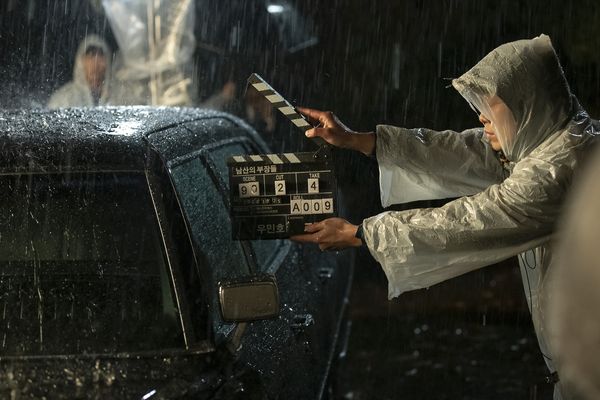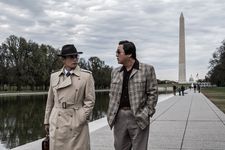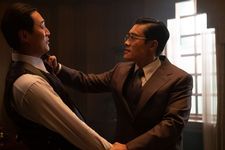 |
| Shooting The Man Standing Next Photo: courtesy of Glasgow Film Festival |
The stylish thriller selected as South Korea's 2021 Oscar submission, The Man Standing Next explores the assassination of President Park Chung-hee in 1979. It's adapted from Kim Choong-seek's book of the same title and focuses of the dilemma faced by the President's right hand man, Kim Kyu-pyeong (played by Lee Byung-hun) as he watches the man he serves become ever more extreme in his thinking. During the Glasgow Film Festival, its director, Woo Min-ho, agreed to answer some questions about how he came to make it and what the process of doing so was like.
Jennie Kermode: What first inspired you to explore this story in film? Had you already read Kim Choong-seek’s book when you decided that it was a subject you would like to address?
 |
| The drive for power Photo: courtesy of Glasgow Film Festival |
Woo Min-ho I've long had the thought of bringing the story of President Park's death to the screen. While the event is one of the most dramatic incidents in modern Korean history, it has been made into a film only once, and I felt that the event should be re-examined from more various angles. I chose the book written by Professor Kim Choong-seek as the original source, as it was absorbing when I first read it while in university. The book, which includes much interesting information on the KCIA [Korean Central Intelligence Agency], is a bestseller that sold more than 400 thousand copies when it was first published in the Nineties. Actually, I wanted to make a film based on this book that portrays the rise and fall of the KCIA, but it was impossible to capture the massive amount of information and the long years in a two hour film. So, I decided to narrow down to the themes of the assassination of President Park and the last director of the KCIA.
JK: Lee Byung-hun is in a difficult position as an actor because he has to show us Kim’s moral conflict even when Kim is trying to hide his emotions from others. How did you work with him to get the balance right?
WM-h: Lee Byung-hun has said that an actor’s job is to be caught by the audience with the character’s true emotions. I believe that perhaps he is the best Korean actor that can perform in a way that makes the audience catch the subtle emotions and hidden inner thoughts without directly expressing them. In fact, Kim Gyu-pyeong is a very difficult character to perform, and I had no other choice than Lee Byung-hun to create the complex layers of ambiguity for the character. That’s why I put in the most effort to get Lee on board the project, and after that, he led the film well by himself with an almost perfect understanding of the character.
 |
| Who's watching who? Photo: courtesy of Glasgow Film Festival |
JK: Was it important to you not to pass judgement on Kim, not to present him as a hero or a villain? What, for you, was the key to understanding him as a character?
WM-h: In Korea, people view Kim Jae-gyu, the real-life figure of Kim Gyu-pyeong, in very different perspectives. An assassin caught in jealousy and ambition for power, or a fighter for democracy that sacrificed himself. Personally, I think he cannot be simply judged in either way. Based upon related references, it seems like he had the mind of a soldier, but could sometimes lose his self-control when his pride was hurt. Also, based on witnesses, it seems like he was struggling until the last moment between his loyalty to President Park’s regime and the ironic will to finish it with his own hands. I believe the emotions and relationship between Kim and President Park are the key factors to understanding the incident. I wanted to vividly portray the two men that shared friendship, built a regime together, but faced with rifts that started small but gradually got bigger, leading to a complete collapse. In the end, I wanted to tell the audience that many historical incidents can also begin from emotions between people.
JK: How did you approach striking a balance between depicting events accurately and creating dramatic interest?
WM-h: Actually, many real events that the film portrays, such as the assassination of President Park and of the ex-Director Park Yong-gak, are dramatic as they are. I tried to approach in a more genre film style rather than a political drama, adding in the aspects of espionage films and cold noir. I referenced the cinematic images of Jean-Pierre Melville and the espionage novels of John le Carré.
 |
| Under pressure Photo: courtesy of Glasgow Film Festival |
JK: There’s a lot of very detailed work in the recreation of the period, from costumes to set decoration. How did you research this and how important do you feel such work is to making a film immersive?
WM-h: I think costumes, hair, makeup, and set design are the most effective devices to deliver the atmosphere of the period to audiences without any explanation. If those parts are neglected, I thought the cinematic atmosphere that the director pursues would be ruined, with the completion of restoring the period aside. So, I paid a lot of attention to those factors for this film, almost like a little paranoid. I wanted to recreate the Seventies fully and, at the same time, create a polished mise-en-scéne, and especially observed the way Director David Fincher expressed colours and textures of objects in the period film such as Zodiac. For example, not just using the colour white to express white, but instead, using an ivory toned white.
JK: The film is beautifully framed and shot. What were your stylistic inspirations?
WM-h: As I’ve mentioned, I observed many of Fincher's period films in terms of using colours and textures. As The Man Standing Next is a film with static atmosphere, I tried to focus the angle on the symmetry and balance to give a slightly pictorial feeling. Perhaps I was unconsciously influenced by numerous films and classical paintings that focused on symmetry and balance.
JK: The events depicted in the film are not widely known outside Korea. With this in mind, are you surprised that it has attracted so much international attention?
 |
| Dangerous times Photo: courtesy of Glasgow Film Festival |
WM-h: At first, it was quite surprising, but when we think about it, there were many similar incidents in other cultures, including Europe, so it might be rather familiar. The most representative one would be the story of Caesar and Brutus. The story of a dictator killed by a close right-hand man could be a sort of classic. Similar incidents happen wherever people live.
JK: How do you feel about the film screening as part of the Glasgow Film Festival?
WM-h: First of all, I am very thankful and happy that The Man Standing Next has been invited to Glasgow Film Festival and presented to UK audiences. If it weren't for Covid-19, I would have been able to communicate with the audience in person and later on fulfil my personal dream of going on a whisky tour. I sincerely hope that there will be another chance for me to visit the festival and also experience Scotland's beautiful nature and amazing whisky in person.





















